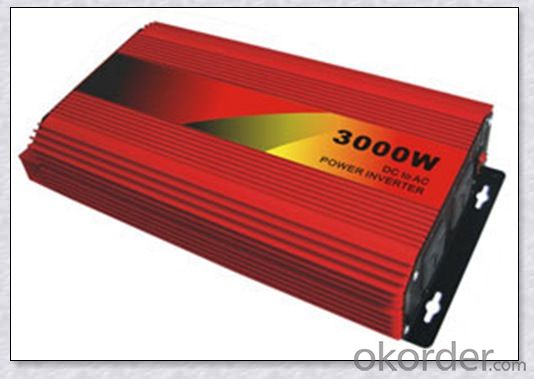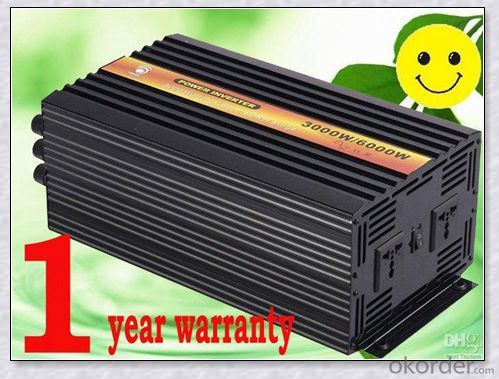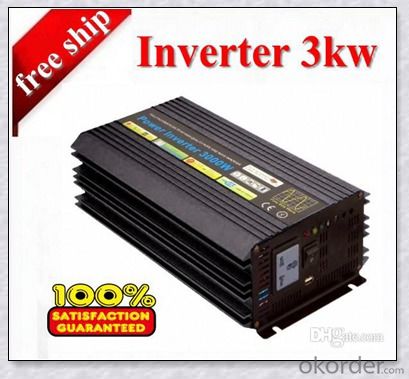Solar Inverter Cage 24V 3000W Leading-Edge Technology
OKorder Service Pledge
OKorder Financial Service
You Might Also Like
Descriptions:
All of our grid-tie inverters are UL listed and code-compliant. We do not stock refurbished grid-tie inverters. Because grid-tie inverters have stricter requirements than off grid inverters, refurbished grid-tie inverters may not be code-compliant. Check with your local electrician or building department before investing in a refurbished grid-tie inverter.
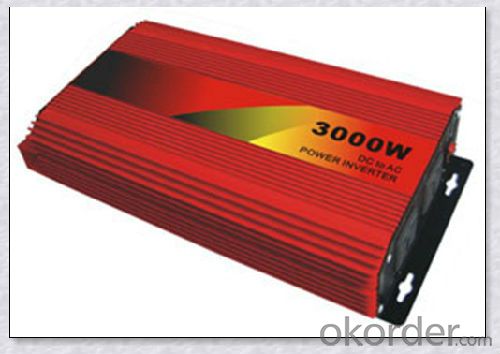
Specifications
INPUT | |
Input voltage range | 185~265±5Vac |
OUTPUT | |
Output voltage range | 185~265±5Vac (AC mode) , 230Vac (DC mode) |
Output frequency (DC mode) | 50Hz (48~54Hz) or 60Hz(58~64Hz), same as AC(AC mode) 50Hz ±0.3Hz (DC mode) |
Wave form | Sine wave (DC Mode) |
Transfer time | 10ms. (Typical) |
BATTERY | |
Rated charging current (max.) | 45A |
Norminal DC input voltage | 24V |
Min. DC start voltage | 20V / 40V |
PHYSICAL | |
Unit dimension (mm) | 526*277*212 |
Master box dimension (mm) | 620*350*370 |
Net weight (1pc, kg) | 32.4 |
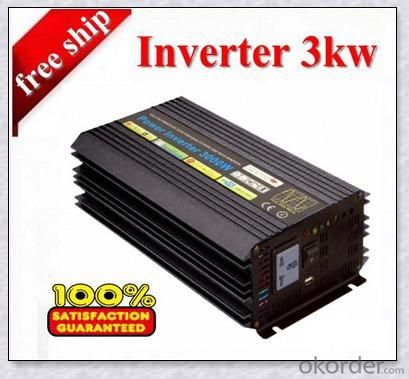
Electronic Protections:
·PV short circuit protection
·PV reverse polarity protection
·PV overvoltage alarm protection
·PV over current protection
·Battery overcharge protection
·Battery over discharge protection
·Battery reverse polarity protection
·Load short circuit protection
·Load overload protection
FAQ:
Q: Do you have any MOQ limit?
Our MOQ is 200 pieces.
Q: Do you offer guarantee for the products?
Yes, we offer one year guarantee for the products.
- Q: Can a solar inverter be used in countries with different electrical standards?
- Yes, a solar inverter can be used in countries with different electrical standards. However, it may require certain modifications or adjustments to ensure compatibility with the local electrical infrastructure. Additionally, the input voltage and frequency of the solar inverter may need to be adjusted accordingly. It is important to consult with local experts or electricians to ensure proper installation and compliance with the electrical standards of the country.
- Q: Are there any government incentives for installing a solar inverter?
- Yes, there are government incentives available for installing a solar inverter. Many countries offer tax credits, grants, or subsidies to promote the use of renewable energy sources like solar power. These incentives aim to encourage homeowners and businesses to adopt solar energy systems, including solar inverters, by offsetting the initial installation costs and promoting sustainability. It is advisable to check with local authorities or consult renewable energy organizations to understand the specific incentives available in your region.
- Q: Can a solar inverter be installed in a residential area?
- Yes, a solar inverter can be installed in a residential area. In fact, it is common for residential homes to have solar inverters installed as part of a solar energy system to convert the direct current (DC) generated by the solar panels into alternating current (AC) that can be used to power household appliances and lighting.
- Q: How does MPPT improve the performance of a solar inverter?
- MPPT (Maximum Power Point Tracking) is a technique used in solar inverters to enhance their performance and maximize the energy output of the solar panels. Solar panels generate direct current (DC) electricity, which needs to be converted into alternating current (AC) to be used by household appliances or fed back to the grid. However, the amount of power generated by solar panels varies depending on factors like sunlight intensity, temperature, shading, and panel orientation. MPPT algorithms enable solar inverters to continuously track and adjust the operating point of the solar panels to extract the maximum power available. By continuously monitoring the voltage and current output of the solar panels, the MPPT controller determines the optimal operating voltage and current that will yield the highest power output. This optimization process is crucial because solar panels have a specific voltage and current combination at which their power output is maximized, known as the maximum power point (MPP). By operating the solar panels at their MPP, MPPT significantly improves the overall efficiency and performance of the solar inverter. With MPPT, solar inverters can adapt to changing environmental conditions and extract the maximum available power from the solar panels. This allows for increased energy production, reducing the reliance on grid electricity and maximizing the return on investment in solar installations. In summary, MPPT improves the performance of a solar inverter by optimizing the operating point of the solar panels to extract the maximum power available. This leads to increased energy production, improved efficiency, and better utilization of solar energy resources.
- Q: How do you calculate the payback period for a solar inverter?
- To calculate the payback period for a solar inverter, you need to determine the initial cost of the inverter and then calculate the annual savings or earnings generated by the inverter. Divide the initial cost by the annual savings to get the payback period, which is the time it takes to recoup the investment through savings or earnings.
- Q: What is the role of a galvanic isolation circuit in a solar inverter?
- The role of a galvanic isolation circuit in a solar inverter is to provide electrical separation and insulation between the DC input side (solar panels) and the AC output side (grid connection). This isolation helps to protect the solar inverter and the electrical grid from potential hazards such as voltage surges, ground faults, or electrical noise. It also improves the safety of the system by reducing the risk of electric shock and prevents the flow of potentially damaging currents.
- Q: Can a solar inverter be used in regions with high temperature extremes?
- Yes, solar inverters can be used in regions with high temperature extremes. However, it is important to consider the temperature range specified by the manufacturer for optimal performance and efficiency. Extreme heat may affect the inverter's efficiency and longevity, so proper cooling and ventilation should be ensured in such conditions.
- Q: What is the role of a solar inverter in a battery storage system?
- The role of a solar inverter in a battery storage system is to convert the direct current (DC) electricity generated by solar panels into alternating current (AC) electricity that can be used to power homes or businesses. It also manages the charging and discharging of the batteries, ensuring efficient storage of excess energy generated by the solar panels and providing a reliable power supply during periods of low solar generation or power outages.
- Q: What is the lifespan of a solar inverter?
- The lifespan of a solar inverter typically ranges from 10 to 20 years, depending on various factors such as the quality of the inverter, usage patterns, maintenance, and environmental conditions.
- Q: Generally a large grid-connected photovoltaic power plant will have several inverters
- , This method is simple to design, easy maintenance, but also for the power grid harmonics smaller, good power quality!
Send your message to us
Solar Inverter Cage 24V 3000W Leading-Edge Technology
OKorder Service Pledge
OKorder Financial Service
Similar products
Hot products
Hot Searches
Related keywords



